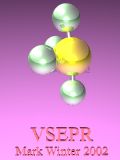 |
|---|
| VSEPR home |
|
|
| The University of Sheffield | |
| Department of Chemistry | VSEPR |
Molecular geometry: VSEPR
VSEPR: Valence Shell Electron Pair Repulsion.
One of the more obviously important properties of any molecule is its shape. Clearly it is very important to know the shape of a molecule if one is to understand its reactions. It is also desirable to have a simple method to predict the geometries of compounds. For main group compounds, the VSEPR method is such a predictive tool and unsurpassed as a handy predictive method. It is a remarkably simple device that utilizes a simple set of electron accounting rules in order to predict the shape of, in particular, main group compounds. Organic molecules are treated just as successfully as inorganic molecules. The assumptions and simplifications required by the method as outlined here should not encroach too far into descriptions of bonding: it is enough that the shape of molecules are successfully predicted.
Application of the VSEPR method requires some simplifying assumptions about the nature of the bonding. Despite this, the correct geometry is nearly always predicted, and the exceptions are often rather special cases. In a complete analysis of the geometry of a molecule it would be necessary to consider such factors as nuclear-nuclear interactions, nuclear-electron interactions, and electron-electron interactions. In the VSEPR method outlined here it is assumed that the geometry of a molecule depends only upon electron-electron interactions.
Some information is also needed before one can apply successfully the VSEPR rules. The connectivity of the atoms in the molecule must be known; in other words, one needs to know which atoms are bonded together. For instance, does the empirical formula C2H6O refer to MeOMe or EtOH? It is also necessary to write down a Lewis electron dot structure for the molecule, but it will emerge that one can sometimes use a simplified Lewis structure.
 |
|---|
|
|